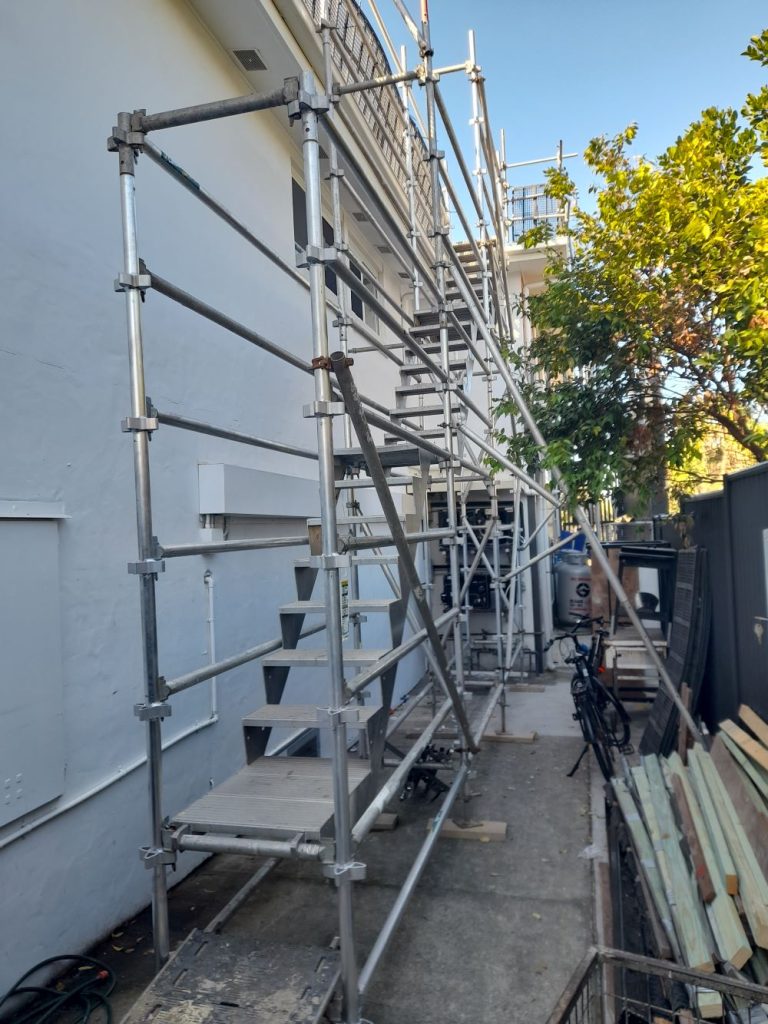If you have ever been involved in scaffolding, you might have contemplated the practicality and safety of placing a ladder on top of it to access elevated areas. Although this may appear to be an easy and convenient solution, it is imperative to assess numerous critical safety factors prior to making that decision. Understanding the inherent risks and following the regulations associated with this practice are essential steps for guaranteeing the safety of yourself and your colleagues in any workspace environment.
While it may appear straightforward, utilizing a ladder atop scaffolding is EXCEEDINGLY hazardous. Incorporating ANY extraneous items into a stable scaffolding structure introduces significant dangers that cannot be overlooked. The risks tied to this practice are considerable and warrant serious attention. In any construction environment, it is crucial to prioritize safety over convenience, ensuring that all measures are taken to mitigate potential hazards.
This article will delve into the various reasons why placing a ladder on scaffolding is inadvisable, shining a light on the potential hazards involved and discussing safer alternatives that should be prioritized instead.

Comprehending the Safety Hazards Associated with Ladder Use on Scaffolding
The unequivocal answer is NO; using a ladder on scaffolding is NOT safe.
Employing a ladder on scaffolding introduces significant dangers that can jeopardize the safety of the entire assembly. The essential purpose of scaffolding is to function as a secure and stable working platform that adheres to strict load-bearing specifications. When a ladder or any additional equipment is placed atop this structure, it can destabilize the entire system, thereby raising the risk of accidents, falls, and severe injuries. Consequently, while it may seem like a clever shortcut to reach a higher area, the potential dangers far outweigh any perceived benefits.
Also Read: What NOT to Do When Using Scaffolding for Safety
Examining the Specific Dangers of Ladder Use on Scaffolding
Having established that using a ladder on scaffolding is inherently unsafe, let’s delve deeper into the specific dangers associated with this practice:
1. Instability of the Scaffolding Structure Compromised by Ladder Placement
Scaffolding is meticulously engineered as a safe and robust working platform, but the introduction of a ladder can significantly disrupt this balance. Ladders are specifically intended to be used on solid ground rather than atop another structure. When a ladder is positioned on scaffolding, it can destabilize the entire assembly, significantly heightening the risk of falls, slips, or even entire scaffold failure. This precarious situation poses a severe danger not only to the user but also to everyone in the vicinity, making it crucial to avoid this practice.
2. Heightened Fall Risk Due to Increased Elevation from Ladder Use
When working on scaffolding, you are already elevated above the ground. Adding a ladder can further amplify this elevation, thereby increasing the risk of falling. The instability created by using a ladder on scaffolding can lead to dangerous situations, particularly if the ladder shifts, slips, or fails to maintain stability. The potential for severe injuries escalates dramatically with higher falls, making this practice exceedingly risky and not worth the gamble.
Also Read: Who Is Responsible for Scaffold Hire and Safety?
3. Improper Ladder Angle Heightens Risk of Accidents
Ladders must be utilized at specific angles to ensure safety during operation. Placing a ladder haphazardly atop scaffolding prevents the achievement of the correct angle necessary for optimal stability. An improperly positioned ladder is highly susceptible to slipping or sliding, especially when set on a surface that lacks proper solidity and support. Furthermore, scaffolding does not offer the same level of stability as a solid ground surface, making it challenging to secure the ladder at the appropriate angle, thus significantly increasing the likelihood of accidents.
4. Lack of Secure Attachment Leads to Serious Hazards
Using a ladder on scaffolding often results in inadequate securing of the ladder itself. Most scaffolding setups are not designed to accommodate ladders, meaning there is generally no reliable method to securely attach them. Although the ladder may initially appear stable, any movement, vibrations, or slips can quickly lead to the ladder falling or tipping over, posing a serious risk to users and those nearby. This lack of security is a paramount concern that cannot be ignored.
5. Non-Compliance with OSHA Safety Regulations Poses Legal Risks
When working on a construction site, adherence to safety regulations is typically mandated. The Occupational Safety and Health Administration (OSHA) enforces stringent guidelines concerning the safe use of scaffolding and ladders. Improperly utilizing a ladder on scaffolding can lead to violations of OSHA standards (such as 1926.1053 for ladders and 1926.451 for scaffolds). Non-compliance can result in serious legal repercussions, including fines, penalties, or even project shutdowns, making it essential to diligently observe safety guidelines to avoid these consequences.
6. Risks of Certification Nullification Due to Unsafe Practices
Every scaffolding installation undergoes a thorough certification process to ensure that professionals have determined it safe for use. Modifying that setup by incorporating a ladder compromises its certification status. In the event of an incident, you may find yourself without coverage regarding work health and safety regulations. Without valid certification, you assume significant risk, which is an unacceptable gamble that could lead to dire consequences for yourself and your team.
Exploring Safer Alternatives for Accessing Elevated Areas Effectively
Now that we have thoroughly examined the reasons against using a ladder on scaffolding, let’s explore safer alternatives for achieving your desired height without compromising safety or violating regulations:
Utilize Built-In Scaffold Access Solutions for Enhanced Safety
Most scaffolding installations are equipped with built-in access features, such as ladders or stairways. These access points are specifically designed to promote safety while navigating up and down the scaffolding. If your scaffolding includes these integral access options, it is imperative to take full advantage of them! They are engineered to work harmoniously with the scaffolding system, significantly bolstering overall security and minimizing the likelihood of accidents during your work.

Consider Work Platforms or Extensions for Safer Access to Heights
Another effective alternative is to use a work platform or an extension. These solutions are specifically designed to provide a stable surface for working while offering safe access to elevated levels. They represent a more secure option than attempting to balance a ladder on scaffolding. Work platforms are robust and certified for use with scaffolding, ensuring your safety while facilitating the efficient and effective completion of tasks at elevated heights without compromising your well-being.
Final Insights on the Risks of Ladder Use with Scaffolding
So, can you safely place a ladder on scaffolding?
The definitive answer is no! Utilizing a ladder on scaffolding can lead to structural instability, heightened fall risk, and violations of critical safety regulations. The potential consequences simply do not justify the associated risks. Instead, prioritize built-in scaffold access methods or opt for safer alternatives, such as work platforms. Always place safety at the forefront; the last thing you want is to jeopardize your well-being or that of others for the sake of convenience. Adhering to proper guidelines will ensure you remain safe and compliant on the job.
The Article: Ladder Safety on Scaffolding: What You Need to Know first appeared on https://writebuff.com
The Article Ladder Safety Tips for Scaffolding You Must Know Was Found On https://limitsofstrategy.com

